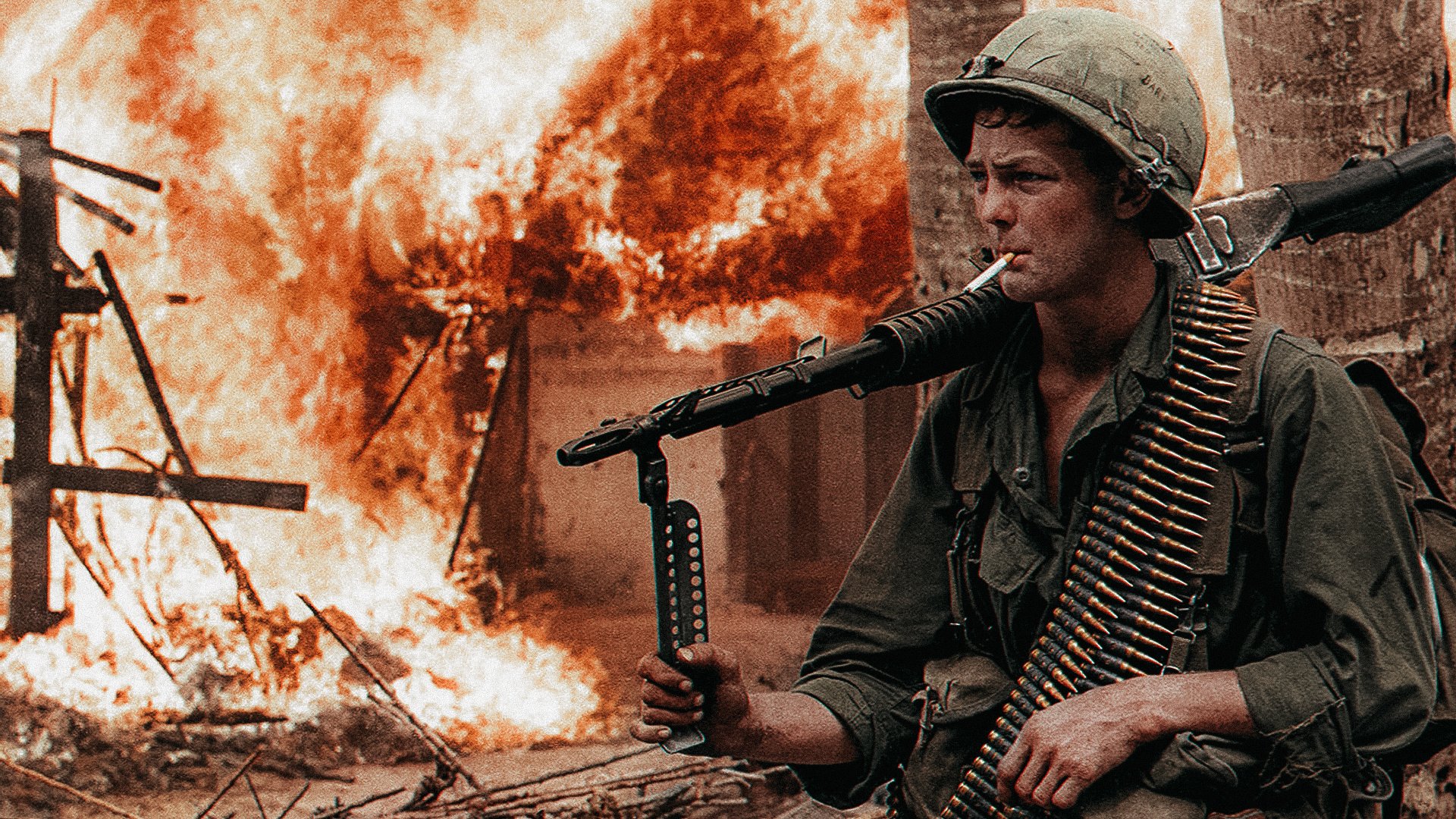
American soldier carries an M60 in Vietnam, 1967. Photo courtesy of Wikimedia Commons.
On the morning of July 22, 1966, a company of United States Marines snaked silently along a densely vegetated jungle trail in Vietnam’s Quang Tri province. Suddenly, machine gun fire erupted. A battalion of North Vietnamese soldiers had ambushed the lead platoon, immediately inflicting mass casualties and pinning down the survivors. Desperate cries for more firepower sounded over the radios. Lance Cpl. Richard Pittman wasted no time answering. He ditched his rifle, picked up a 23-pound M60 machine gun, and rushed forward.
With little regard for his own safety, Pittman went on the offensive. He destroyed two enemy machine gun positions at point-blank range before braving incoming mortars to reach the front of the patrol. When he found the wounded Marines, a force of 30 to 40 enemy soldiers charged his position.
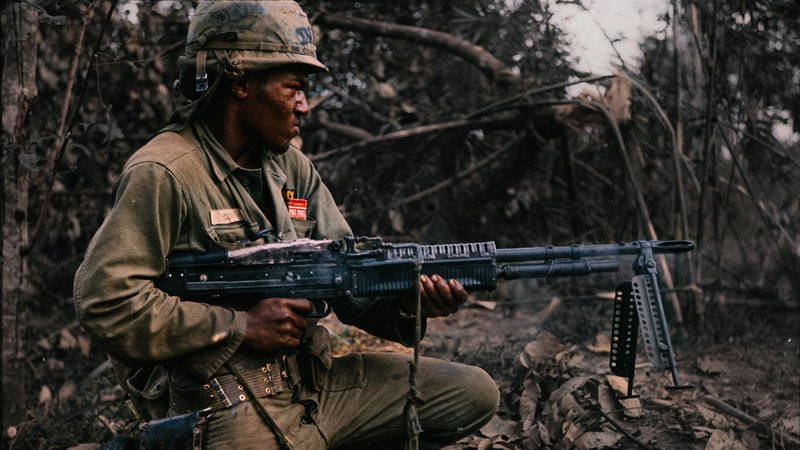
Pfc. Milton Cook fires his M60 near Cu Chi, Vietnam, during Operation Cedar Falls, 1967. Photo courtesy of Wikimedia Commons.
Undaunted, Pittman positioned his M60 in the center of the trail and opened fire. Leaning into the buttstock of the machine gun, Pittman cut down waves of attackers. When he ran out of ammunition, he grabbed one of the wounded Marines’ submachine guns and continued to fight back. And when he ran out of ammo again, he hurled a grenade and started dragging casualties to the rear.
For thwarting the enemy’s attack, and likely saving his entire company, Pittman was awarded the Medal of Honor.
Related: Animal Mother and the Duality of Man in ‘Full Metal Jacket’
The M60 in Vietnam
Pittman wasn’t the only service member to rely on the M60 during the Vietnam War. First issued in 1959, the belt-fed medium machine gun was eventually mounted on virtually every type of vehicle in the US military’s arsenal — helicopters, tanks, trucks, and even boats. Although technically a crew-served weapon, the M60 was light enough to be carried by a single soldier, making it ideal for ground forces.
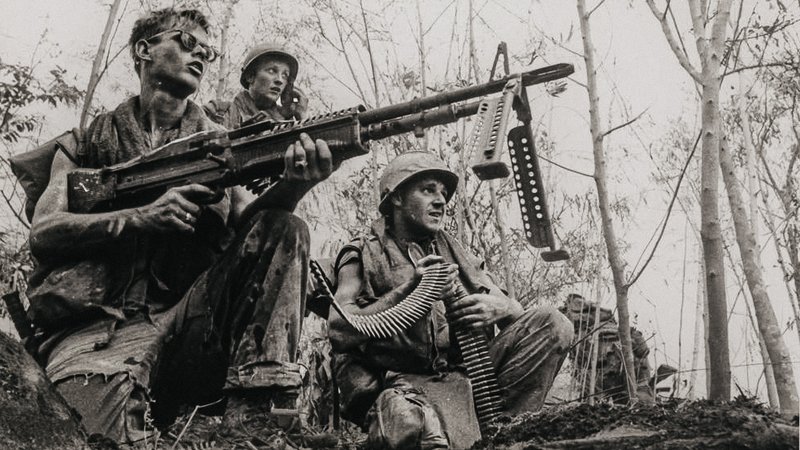
Marines with Lima Company, 3rd Battalion 7th Marines, return fire with an M60 south of Da Nang, 1968. Photo courtesy of Wikimedia Commons.
In time, the M60 earned a reputation among American troops as an indispensable weapon. Chambered in 7.62mm, the gun could effectively fire 650 rounds per minute at a range of up to 1,200 yards. The weapon's high rate of fire and maximum effective range made it far superior to its World War II and Korean War predecessors, like the Browning Automatic Rifle and the M1919. Nicknamed “the Pig” because of its voracious appetite for ammunition, the M60 remained an integral tool for Army and Marine Corps infantry squads until the 1990s.
Related: How the Huey Helicopter Became the Workhorse of the Vietnam War
A Not-So-Perfect Pig
While the M60 was loved for its ability to be carried by a single soldier, the gun still weighed a back-breaking 30 pounds when loaded with a standard 100-round contact belt. It was also prone to malfunctions.
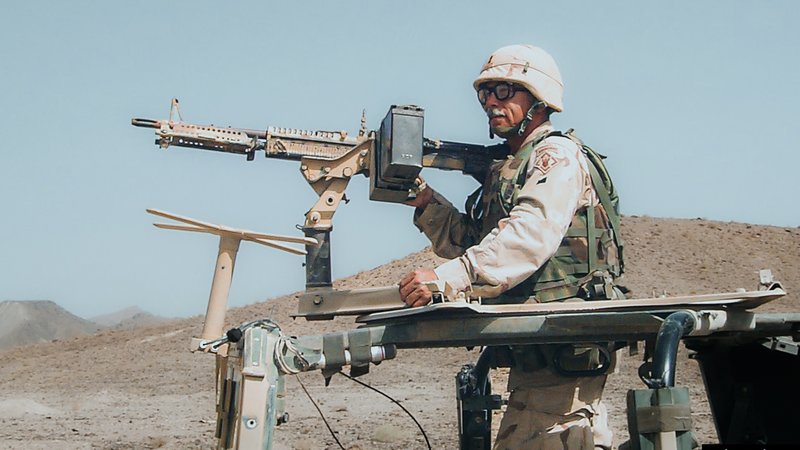
Chief Warrant Officer 5 Ralph E. Rigby mans a mounted M60 during a patrol in Afghanistan’s Paptika province in July 2004. No other individual in the unit had been trained on the legacy weapon, so Rigby volunteered for the mission. US Army photo.
The wet and dirty conditions of the Vietnamese hinterlands frequently caused the M60 to jam. The weapon regularly failed to extract spent brass from the chamber, forcing the gunner to prematurely swap barrels. Additionally, the gun’s swinging lever jutted out awkwardly. The lever was prone to snag on the gunner’s equipment and inadvertently detach the barrel.
The weapon’s most significant flaw was the ease with which its sear wore down. The sear held the bolt back until enough trigger pressure was applied, so its erosion often resulted in a “runaway gun.” This meant the M60 would continue firing after the gunner stopped squeezing the trigger. In its efforts to resolve these issues, the US military eventually produced eight improved variants of the M60.
Related: Marines and Soldiers Agree: The M240 is the Best Machine Gun
The M60 Series of Machine Guns
The first variant was the M60E1. While the bipod on the original M60 was located under the barrel, the M60E1’s was attached to the gas tube, which made barrel changes easier.
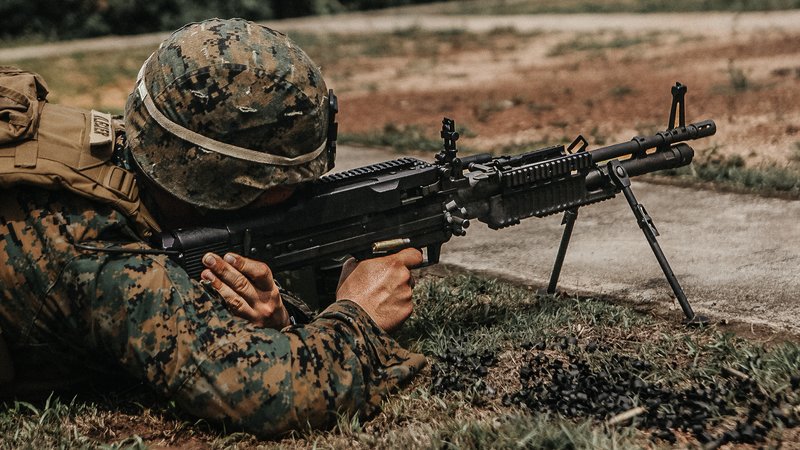
US Marine Sgt. Charles R. Klecker, an infantry tactics trainer with Mobile Training Team One, Special Purpose Marine Air-Ground Task Force-Southern Command, fires the M60 machine gun as part of a demonstration at Agustin Santos Vinda Base in Quebrada de Piedra, Panama, Aug. 29, 2017. US Marine Corps photo by Lance Cpl. Serine Farahi.
The weapon platform didn’t undergo any other major improvements until 1986, when the M60E3 was introduced. The M60E3 featured a receiver-mounted bipod, an ambidextrous safety, and a simplified gas system. It also sported universal sling attachments and a carrying handle. The new design shaved five pounds off the original M60 design; however, the lighter frame and skinnier barrel were more prone to breaking and overheating.
By the turn of the century, the M60 series of machine guns was being replaced by the heavier — albeit more reliable — M240 as well as the lighter, 5.56-firing M249. And while most Army and Marine Corps units transitioned to the newer weapons, the Navy SEALs embraced the M60’s final iteration: the M60E4.

A Navy SEAL fires an M60 during a training event, 1987. Photo courtesy of Wikimedia Commons.
The M60E4, also known as the Mk43, proved to be the most reliable M60 model. It came with three barrel options: a long barrel, a short barrel, and an even shorter “assault” barrel. The assault barrel brought the overall weight of the weapon down to 21 pounds, rendering it one of the most manageable medium machine guns ever built. Furthermore, the three barrel options were lined with stellite, which improved the weapon’s heat resistance and overall longevity. The Mk43 also came with rails for attaching optics and lasers as well as an adjustable front sight.
Related: ‘Butter Butter Jam’: Troops Loved, and Hated, the M249 SAW
Vehicle-Mounted M60s
In addition to the variants designed for ground forces, several more M60 variants were made specifically for mounting to vehicles. The M60E2 was designed for armored vehicles and M60 Patton tanks. The M60E2 was manufactured without a pistol grip or buttstock and was intended to be fired electronically with a remote. Its gas tube was also larger than the ground-variants so gas could be expended outside of the vehicle.
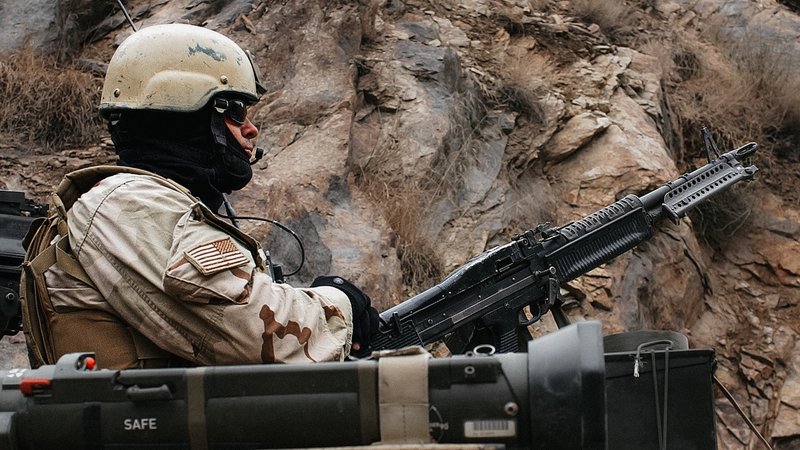
A Green Beret with 19th Special Forces Group mans an M60 near Asadabad, Afghanistan, 2004. US Army photo by Sgt. Horace Murray.
There was also the M60B, which was made for helicopters, except its manufacturers neglected to equip it with the necessary mount. This major oversight led to the M60B quickly becoming replaced by the M60D. The M60D was pintle-mounted and featured a spade grip rather than the standard pistol grip. It was controlled by a designated door-gunner rather than the helicopter’s pilot. The M60C, on the other hand, closely resembled the M60D but featured an electronic control system. This allowed pilots to control and fire the machine gun from the cockpit.

Crew members prepare for a live fire exercise on the flight deck aboard the Nimitz-class aircraft carrier USS Theodore Roosevelt (CVN 71). US Navy photo by Mass Communication Specialist Seaman Sheldon Rowley.
Today, the M60 — and all of its variants — are rarely used by American troops as they have been surpassed by newer, better machine guns. Nevertheless, some Coast Guard, Navy, and reserve units still cling to the old Pig for use in amphibious operations.
Read Next: What Really Happened at Vietnam’s Hamburger Hill?

Mac Caltrider is a senior staff writer for Coffee or Die Magazine. He served in the US Marine Corps and is a former police officer. Caltrider earned his bachelor’s degree in history and now reads anything he can get his hands on. He is also the creator of Pipes & Pages, a site intended to increase readership among enlisted troops. Caltrider spends most of his time reading, writing, and waging a one-man war against premature hair loss.
BRCC and Bad Moon Print Press team up for an exclusive, limited-edition T-shirt design!
BRCC partners with Team Room Design for an exclusive T-shirt release!
Thirty Seconds Out has partnered with BRCC for an exclusive shirt design invoking the God of Winter.
Lucas O'Hara of Grizzly Forge has teamed up with BRCC for a badass, exclusive Shirt Club T-shirt design featuring his most popular knife and tiomahawk.
Coffee or Die sits down with one of the graphic designers behind Black Rifle Coffee's signature look and vibe.
Biden will award the Medal of Honor to a Vietnam War Army helicopter pilot who risked his life to save a reconnaissance team from almost certain death.
Ever wonder how much Jack Mandaville would f*ck sh*t up if he went back in time? The American Revolution didn't even see him coming.
A nearly 200-year-old West Point time capsule that at first appeared to yield little more than dust contains hidden treasure, the US Military Academy said.












